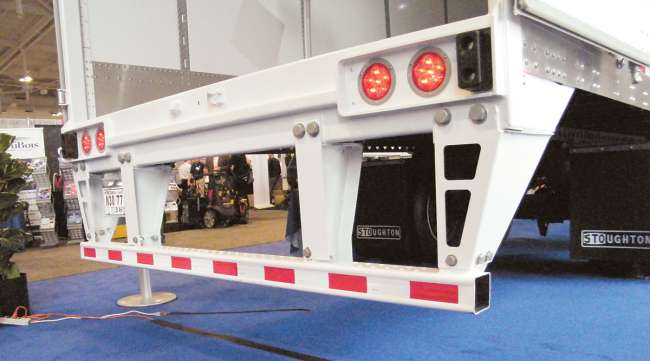Senior Reporter
FMCSA Proposes to Add Truck Rear Underride Guards to Safety Checklist

[Stay on top of transportation news: Get TTNews in your inbox.]
The Federal Motor Carrier Safety Administration has issued a proposed rule amending federal safety regulations to specifically add rear impact guards as a required item on the list of annual inspections for motor carriers and roadside inspectors.
The proposal, announced Dec. 29 in a federal register post, will, if finalized, mean that a check of truck rear underride guards will become a part of the CMV inspector process, said Collin Mooney, executive director of the Commercial Vehicle Safety Alliance. Currently, while motor carriers are required to maintain and annually inspect their underride guards, some CVSA inspectors do not cite a trucker when they observe a damaged or loose rear guard, Mooney said. However, if the new regulation becomes final, “then we obviously will inspect as well,” Mooney said. “We’ll be taking a closer look at underride guards.”
Mooney said there is a current “catch all” regulation requiring that a trucker’s underride guard not be damaged, but the decision on whether to issue a citation differs among inspectors. “But you really don’t want rules to be subjective,” he said. “You want them to be pretty black and white.”

Mooney
Since 1952, most trucks and trailers have been required by regulation to install rear underride guards designed to withstand the force of a crash and prevent a car from sliding under a truck. FMCSA said that the new requirement would not significantly affect most motor carriers.
Despite the longstanding federal requirement, a 2019 federal government watchdog study recommended that federal regulators take steps to collect better data on underride guard crashes and share information with police departments in identifying underride crashes.
“Although reported underride crash fatalities represent a small percentage of total traffic fatalities, they present a greater risk of fatalities or serious injuries,” said an April 2019 report released by the U.S. Government Accountability Office.
Rear Impact Guards and Rear Impact Protection by Transport Topics on Scribd
From 2008-17, there was an average of 219 fatalities in truck-involved underride crashes annually, about 5.4% of the total truck-involved crash fatalities each year, the GAO study said.
“While the [federal regulations] have required rear impact guards for more than 65 years, they are not included on the list of components in Appendix G that must be inspected during the annual CMV inspection,” the FMCSA proposal said. “This means that a vehicle can pass an annual inspection with a missing or damaged rear impact guard.”
Appendix G is a regulatory provision that identifies the vehicle components that are to be inspected.
A vehicle’s rear impact guard/rear end protection is inspected roadside as part of the North American Standard Inspection Program. According to data available through FMCSA’s Analysis and Information Online web page, in fiscal 2017, inspectors documented more than 2,300 violations related to rear impact guards and rear end protection, more than half of which were for components that are missing, damaged or improperly constructed.

In this year in review episode, we discuss COVID and everything from gas tax to remote work. With the help of our special Transport Topics guests, Seth Clevenger and Eleanor Lamb, we’ll also begin to map a plan for 2021. Hear a snippet, above, and get the full program by going to RoadSigns.TTNews.com.
But FMCSA said that including rear impact guards and rear end protection in the periodic inspection requirements will call additional attention to the critical safety component and help ensure that each vehicle is checked at least once a year, improving compliance and helping to prevent fatalities and injuries when rear-end collisions occur.
RELATED: ATA Reaffirms Opposition to Side Underride Guard Legislation
“Including rear impact guards and rear end protection in the periodic annual inspection standards will harmonize U.S. regulations with those in Canada and Mexico, which include rear impact guards and rear end protection as part of their annual inspection programs,” the FMCSA proposal said.
The GAO concluded that the lack of an annual inspection requirement for rear impact guards potentially affects the safety of the traveling public and FMCSA’s ability to achieve its safety mission. GAO stated, “Without explicitly including the inspection of the rear guard in Appendix G, there is no assurance that rear guards in operation will be inspected at least annually to ensure they perform as designed to prevent or mitigate an underride crash.”
Want more news? Listen to today's daily briefing:
Subscribe: Apple Podcasts | Spotify | Amazon Alexa | Google Assistant | More




